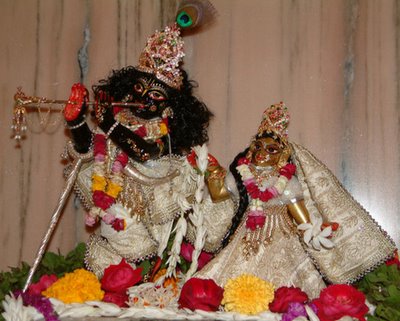 The Reappearance of Sri Sri Radha-Madhava
The Reappearance of Sri Sri Radha-Madhava
The discovery of the ancestral deities of Srila Bhaktivinoda Thakura.
By Bhaktarupa Dasa
FIVE HUNDRED years ago when Lord Sri Caitanya Mahaprabhu launched the sankirtana movement of the congregational chanting of the holy names of the Lord, He commissioned His closest associates to spread the movement everywhere. On the order of Caitanya Mahaprabhu, Nityananda Prabhu traveled extensively throughout Bengal, humbly begging everyone He met to chant the holy names and worship Sri Sri Radha-Krsna. Many Bengalis surrendered at His lotus feet, becoming His disciples and adopting the Gaudiya Vaisnava way of life. Among these disciples was Krishnananda Dutta, a wealthy landowner residing in Ulberia, not far from present-day Calcutta.
Krishnananda Dutta worshiped deities of Sri Sri Radha-Madhava in his home in Ulberia until his retirement from family affairs. Then, taking the deities with him, he moved to the holy place Puri, Orissa, home of the famous temple of Lord Jagannatha. In Puri, Krishnananda lived a pious and simple life, not speaking to anyone, but chanting the Hare Krsna maha-mantra the whole day and night and worshiping Sri Sri Radha-Madhava. After living in Puri for some time, he met the feudal king of Ali State, about two hundred kilometers from Puri. Impressed with Krishnananda’s spiritual qualities, the king invited him to live in his state, where he donated an entire village, named Choti (formerly called Choti Mangalpur), to the worship of Sri Sri Radha-Madhava.
The descendants of Krishnananda Dutta worshiped Sri Sri Radha-Madhava in Choti from generation to generation. Eventually the worship passed into the hands of his descendent Kedaranath Dutta (1838–1914), who is well-known to all Gaudiya Vaisnavas as Srila Bhaktivinoda Thakura, the great saint who was the first to present the teachings of Caitanya Mahaprabhu in a modern context.
Srila Bhaktivinoda Thakura wrote hundreds of songs glorifying the Supreme Lord in Bengali, Sanskrit, and Brajaboli (a dialect that combines Bengali, Sanskrit, and Oriya). His songs capture the essence of Gaudiya Vaisnava philosophy. One, Jaya Radha-Madhava, was a favorite of Srila A. C. Bhaktivedanta Swami Prabhupada, who would sing it every day just before his public lectures. This song paints a beautiful picture of the pastimes of Srila Bhaktivinoda Thakura’s beloved deities Sri Sri Radha-Madhava.
After the departure of Srila Bhaktivinoda Thakura, the worship of Sri Sri Radha-Madhava was handed down to his son, Bimala Prasad Dutta, also known as Srila Bhaktisiddhanta Sarasvati Thakura, the spiritual master of Srila Prabhupada. Because Srila Bhaktisiddhanta was a lifelong celibate and a dedicated traveling preacher, whenever he would visit Choti he would not enter into his ancestral home there; he would visit the temple of Sri Sri Radha-Madhava and stay in the nearby Dassahera Mandap.
Unfortunately, after Srila Bhaktisiddhanta’s departure from this world the worship became neglected. A neighboring family schemed to lay their own claim on the lands belonging to the deities and secretly moved the deities to another village. This family claimed that the deities had become broken and thus, according to traditional practice, had to be submerged in the nearby Birupa River.
In the terminology of Gaudiya Vaisnavas, the native place of a great saint is called a sripat, and such places are considered worshipable by all the followers of the saint. But just as the village of Choti was deprived for five decades of seeing its proprietors, Sri Sri Radha-Madhava, the village—the native place of Srila Bhaktivinoda Thakura and Srila Bhaktisiddhanta Thakura—became all but forgotten by the spiritual descendants of these two great saints during that time. Now, though, ISKCON devotees from Bhubaneswar sometimes perform sankirtana in Choti.
Dedicated Researcher
Fortunately for us all, Bhaktivinoda Thakura left information about his connection with Choti in his autobiography. Dr. Fakir Mohan Das, a research scholar and professor at Utkal University in Bhubaneswar, and one of Bhaktivinoda Thakura’s spiritual descendants, came across this information. Starting in 1982, Dr. Das visited Choti whenever he had the opportunity, and through painstaking research he eventually uncovered and published the facts about the history of the place for the benefit of the Gaudiya Vaisnava community. But the challenge of reestablishing the worship of Sri Sri Radha-Madhava in Choti remained.
Dr. Das was never fully satisfied with the story of how the deities had been submerged in the river, and he continued to make inquiries. Finally, in January 2000, after nearly twenty years of searching, he found Sri Sri Radha-Madhava in the house of a brahmana, Sri Duryodhana Dwivedi, where They had been secretly moved in about 1950. Sri Dwivedi was keen to hear of the international interest that would be generated by Their discovery, and he happily donated Their Lordships to a group of devotees headed by ISKCON Governing Body Commissioner His Holiness Bhaktisvarupa Damodara Swami, under the guarantee that Their worship would be reestablished in Choti on Their traditional lands.
Presently They are being worshiped in Bhubaneswar pending the construction of a new temple for Them in Choti.
[Note: At the time of this blog, Sri Sri Radha Madhava are staying in Kendrapara (about 3 hours Northeast of Bhubaneswar), still waiting for a temple to be built for them in nearby Choti. -- MD]




No comments:
Post a Comment